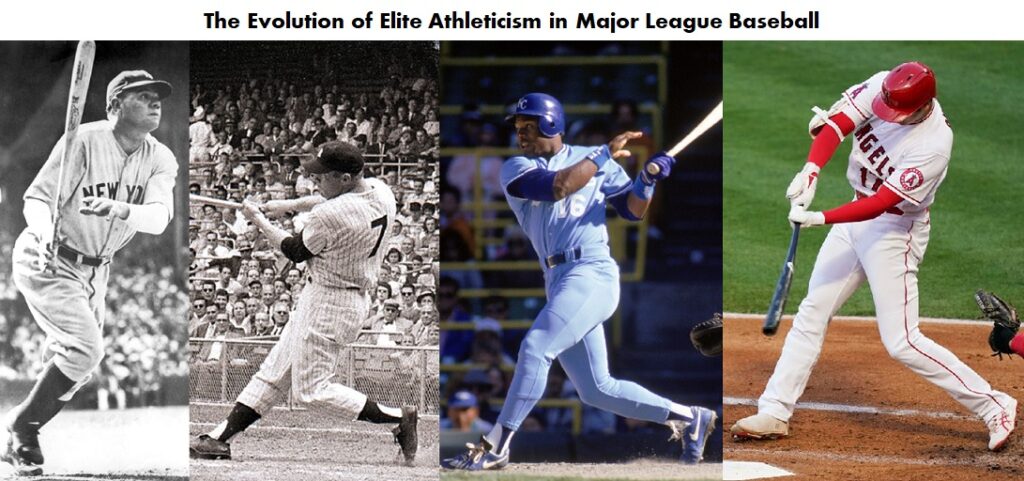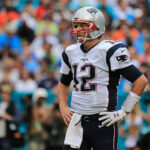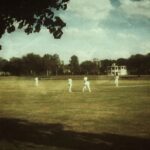Shohei Ohtani Latest in Evolution of Elite Athletes in Baseball

There are quite a few exciting young players in Major League Baseball, but while most of them fit the traditional model of players in baseball history, in my opinion one stands out as part of a very elite lineage of special athletes in baseball.
Whether he is throwing a 100 MPH fastball, launching a tape measure home run or gliding around the bases like an Olympic sprinter, Shohei Ohtani is clearly a unique athlete within the current game of baseball.
In my opinion, Ohtani is the fourth player over the last 100 years who stood out from the crowd, not just in relation to their baseball production, but more specifically in how their unique level of freak athleticism allowed them to do things never seen before.
The first of these four was Babe Ruth. Though most common images of him are from later in his career when he was slightly overweight, the reality is that the young Babe Ruth was a transcendent athlete who forever changed the game of baseball.
Ruth first burst on the scene in 1914 as a 19-year-old left-handed pitcher for the Boston Red Sox. He posted an 18-8 record with 2.44 ERA as a 20-year-old in 1915 and then won 23 and 24 games respectively over the next two seasons. He also led the American league with a 1.75 ERA in 1916.
Part of three World Series Championship teams in four seasons with the Red Sox between 1915 and 1918, Ruth set a World Series record by pitching 29.2 consecutive scoreless innings (it stood until 1961).
His personality made it hard for Ruth to sit on the bench for three or four straight days in-between pitching start, so it wasn’t long before he started pushing to get into the field when not on the mound. The fact that he hit .315 with four home runs and 20 RBI in just 92 at bats in 1915 didn’t hurt.
By 1918 he was splitting time on the mound and in the field. In 1918 he went 13-7 with a 2.22 ERA in 20 starts on the mound. He also claimed his first home run title as he hit 11 homers with 61 RBI and a .300 average in 95 games.
His transition to a position player escalated in 1919 as he started 106 games in left field and only 15 on the mound. It was very clear that while he was a great pitcher, he was a special hitter as Ruth led the league with 29 home runs, 113 RBI and 103 runs while hitting .322.
Even in limited opportunities as a hitter, it was clear that Ruth was a slugger unlike any the game had ever seen. His 29 home runs in 1919 established a new major league record and were 19 more than the second place finisher in the American League.
His proficiency at the plate was earning him great notoriety in the media and bringing people to the ballpark.
It was after the 1919 season that Boston owner Harry Frazee made the infamous decision to sell his greatest player to the New York Yankees for $100,000 in cash and a $350,000 loan.
With the Yankees, Ruth became almost exclusively a position player. He would pitch only five games for New York during his tenure with the team.
Focusing only on hitting and fielding, Ruth quickly escalated his power level to a place never previously experienced in professional baseball. He blasted 54 home runs in 1920 and 59 in 1921. His 54 home runs in 1920 were more than the combined total for every other team in baseball except for the Philadelphia Phillies, who hit 64.
He would go on to win 12 American League Home Run titles between 1919 and 1931. He broke his own single-season record with 60 home runs in 1927.
All told, in 15 seasons with the New York Yankees, Ruth hit .349 with 659 home runs, 1,978 RBI and 1,959 runs scored. The Yankees played in seven World Series during his tenure, winning four titles.
In my opinion, there are two things that lift Ruth into the category of all-time elite baseball athlete.
First is the greatness he showed as a pitcher with the Red Sox. Had he not eventually moved exclusively to the field, he could have been one of the greatest pitchers in league history. His career pitching record of 94-46 with a 2.28 ERA is quite impressive given that he only pitched 163 games and 1,221 innings during his career.
The second thing that stands out about Ruth is the great disparity between his home run prowess and that of the rest of baseball, especially early in his career.
As mentioned earlier, it was not uncommon early in his career for him to have more home runs than most teams in the league. Even as home runs became more a staple of the game throughout the 1920s, Ruth still dominated the league in that category. He also was a solid defensive player and also registered 123 stolen bases during his career.
The second player who changed the game with his athleticism also wore the pinstripes of the New York Yankees.
When he joined the New York Yankees in 1951, Mickey Mantle was a raw country boy from Oklahoma with untapped athletic ability. Expected to be the next great Yankee star, he was originally given the number 6 following that of Babe Ruth (#3), Lou Gehrig (#4) and Joe DiMaggio (#5).
Possessing great athleticism and switch-hitting power from both sides of the plate, legendary Yankees manager Casey Stengel said that “he’s got more natural power from both sides than anybody I ever saw.”
After struggling early and being sent down to the minors where he very nearly quit the game, Mantle returned midway through the season and wearing a new number (#7) quickly became a major part of the lineup. He finished the season hitting .267 with 13 home runs and 65 RBI in 96 games.
During the second game of the World Series, Mantle tripped over an exposed drain pipe, suffering what turned out to be a torn ACL. Because of the limited medical capabilities of the time, the ACL tear was not completely repaired and Mantle was plagued by knee injuries for the remainder of his career.
Even with a bad knee, Mantle quickly displayed an athleticism and power unlike anyone who had played in the game before him.
Much like Ruth decades earlier, Mantle did things that no other player was capable of achieving. He routinely could launch mammoth home run blasts from either side of the plate. In 1960, he reportedly hit the longest home run in major league history, launching a blast over the right field roof at Briggs Stadium in Detroit, reportedly measuring 643 feet.
He also was known for his great speed around the basepaths and in the field. He ranks 10th in baseball history with 80 bases-empty bunt hits during his career. He also had 153 career stolen bases and was thrown out only 38 times.
Even though he battled injuries and a tendency to indulge in the New York night life throughout his career, Mantle still produced statistical numbers that are among the elite in baseball history.
He won the American League triple crown in 1956 and was the league MVP in 1956, 1957 and 1962. A four-time AL home run champion, Mantle twice hit more than 50 home runs in a season. He ranks first among switch hitter in baseball history with 536 career home runs.
In my opinion, what pushes Mantle into the category of all-time elite athlete in baseball history is not his great statistical numbers, but his raw athleticism, unique power and success as a switch hitter.
It would be nearly 20 years after Mantle’s retirement before another player with similar athleticism would emerge in professional baseball.
Bo Jackson first made a name for himself as a tailback for the Auburn University football team. A Heisman Trophy winner on the football field, Jackson was also a baseball standout for the Tigers. He had previously been selected by the New York Yankees in the second round of the 1982 major league draft before deciding to play college football.
He played both sports at Auburn and as a junior in 1985 hit .401 with 17 home runs and 43 RBI.
Though he was unable to play his final year of college baseball due to a purposeful deception by the owners of the Tampa Bay Buccaneers that led to him being ruled ineligible by the NCAA, Jackson still loved baseball and had an interest in pursuing the sport at the professional level.
Jackson was drafted first overall in the 1986 NFL Draft by the Buccaneers, but refused to sign with the team and instead signed with the Kansas City Royals, who had drafted him in the fourth round of the MLB draft.
Though considered a raw prospect who needed game experience to improve, Jackson spent only 53 games in the minors before being called up to the Royals in September 1986.
He made the team out of spring training in 1987 and blasted 22 home runs during his rookie season. The following year, Jackson hit 25 home runs and stole 27 bases. He also displayed one of the best arms in baseball, routinely gunning down runners on the bases. The greatest of these plays occurred against the Seattle Mariners when he threw a perfect strike from nearly the outfield wall to gun out the speedy Harold Reynolds.
Drafted by the Oakland Raiders in the fourth round of the 1987 NFL Draft, Jackson decided to become a two-sport athlete with baseball as his primary sport and then playing as many games as possible for the Raiders once the MLB season ended.
He played seven games for the Raiders in 1987 and rushed for 554 yards, an average of 6.8 yards per carry. In a Monday Night Football Game against the Seattle Seahawks, Jackson rushed for 221 yards, including a 91-yard touchdown run. He also made a play-for-the-ages when he ran over much-hyped linebacker Brian Bosworth on his way into the end zone.
As many expected, the more major league at bats Jackson received, the better he became as a professional hitter. In 1989 he was selected as a starter for the American League All-Star team.
After stopping a potential National league rally with a running catch in the gap during the top of the first inning, Jackson led off the bottom of the first with a monstrous 448-foot home run. He ended up being named the All-Star game MVP.
He finished the 1989 season with career-best totals of 32 home runs, 105 RBI and a .256 batting average, but also led the league with 172 strikeouts.
Jackson rushed for a career-high 950 yards in 11 games during the 1989 NFL season.
In 1990, Jackson hit 28 home runs for the Royals, but was limited to only 111 games due to injuries. He then joined the Raiders and rushed for 698 yards in 10 games to earn his first trip to the NFL Pro Bowl.
Unfortunately, Jackson did not get to play in that game as his NFL career came to a shocking end when he suffered a severe hip injury during a playoff game against the Cincinnati Bengals.
That injury proved to be the end of his career with the Kansas City Royals as the team released Jackson before the 1991 season, rather than pay his contract while rehabbing from injury.
Despite his injury, Jackson was signed by the Chicago White Sox and was able to hit three home runs while playing in 23 games late in the season.
After having his hip replaced in 1992, Jackson returned in 1993 and hit a dramatic home run in his first game of the season. He went on to play in 85 games and finished with 16 home runs, 45 RBI and a .232 batting average. The White Sox advanced to the American League Championship Series, but Jackson went o-for-10 with three walks in the series.
He finished his career the following season hitting 13 home runs in 75 games for the California Angels.
Much like Mantle, what made Jackson a part of the athletic evolution in major league history was not necessarily his statistical performance, but his jaw-dropping athleticism and ability to make plays that no one else could achieve.
Had he not played football and suffered a career-altering hip injury, many believe that Jackson could have developed into an all-time baseball great.
Though there have been many outstanding baseball talents since Jackson, none reached the level of eye-popping elite athleticism until the man from Japan joined the Los Angeles Angels in 2018.
Touted as a great talent both as a pitcher and hitter, many still were skeptical that Ohtani could perform at the highest professional level at both.
It didn’t take long for him to prove his critics wrong as Ohtani was named the American League Rookie of the Year in 2018. He hit 22 home runs with 61 RBI and a .285 average in 104 games. He also went 4-2 with a 3.31 ERA in 10 starts while firing a fastball that regularly reached 100 miles per hour.
When Ohtani underwent Tommy John Surgery in 2019, many questioned whether his days as a two-way player were over.
However, he has again silenced any doubts in 2021, earning a spot on the All-Star team as both a pitcher and hitter. He currently leads MLB with 33 home runs, many of them long tape-measure blasts reminiscent of those blasted by Ruth, Mantle and Jackson. He also has a 4-1 record with a 3.49 ERA and 87 strikeouts as a pitcher.
From Ruth to Mantle then Jackson and now Ohtani, the evolution of the athlete in Major League Baseball has gone full circle from a two-way player to a pair of amazing athletes and now back to another two-way star moving the game to another level.
It may take another couple decades, but I can’t wait to see what awaits in the next evolution of athlete in professional baseball.













